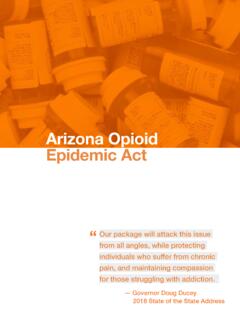Transcription of Guideline on the clinical development of medicinal ...
1 30 Churchill Place Canary Wharf London E14 5EU United Kingdom An agency of the European Union Telephone +44 (0)20 3660 6000 Facsimile +44 (0)20 3660 5555 Send a question via our website European Medicines Agency, 2016. Reproduction is authorised provided the source is acknowledged. 15 December 2016 EMA/CHMP/970057/2011 Committee for medicinal Products for Human Use (CHMP) Guideline on the clinical development of medicinal products intended for the treatment of pain Draft Agreed by Biostatistics Working Party December 2012 Draft Agreed by Paediatric Committee March 2013 Draft Agreed by Central Nervous System Working Party May 2013 Adoption by CHMP for release for consultation 30 May 2013 Start of public consultation 1 June 2013 End of consultation (deadline for comments)
2 30 November 2013 Draft Agreed by Central Nervous System Working Party October 2015 Adoption by CHMP for release for 2nd consultation 17 December 2015 Start of public consultation 21 December 2015 End of consultation (deadline for comments) 31 March 2016 Agreed by Central Nervous System Working Party 2 December 2016 Adopted by CHMP 15 December 2016 Date of coming into effect 1 July 2017 This Guideline replaces guidelines CPMP/EWP/252/03 Rev. 1 and CPMP/EWP/612/00 Keywords pain, neuropathic, nociceptive, chronic, acute, analgesia, mild, moderate, Guideline , medicinal products Guideline on the clinical development of medicinal products intended for the treatment of pain EMA/CHMP/970057/2011 Page 2/29 Guideline on the clinical development of medicinal products intended for the treatment of pain Table of contents 1.
3 Executive summary .. 4 2. Introduction (background) .. 4 3. Scope .. 6 4. Legal basis .. 6 5. General considerations for clinical development .. 7 clinical Pharmacology .. 7 Pharmacokinetics .. 7 Pharmacodynamics .. 7 Interaction studies .. 8 clinical Efficacy .. 8 Methods to assess efficacy .. 8 Exploratory studies .. 9 Dose-Response Studies .. 9 Confirmatory efficacy studies (acute and chronic pain) .. 10 Investigation of maintenance of effect and development of tolerance .. 13 6. Specific Considerations for clinical development .
4 14 Acute Pain .. 14 Chronic Pain .. 16 General considerations .. 16 Nociceptive Pain .. 17 Neuropathic Pain .. 17 Mixed Pain .. 18 Efficacy studies in chronic pain .. 18 Cancer Pain .. 20 Breakthrough Pain .. 21 Fibromyalgia Syndrome .. 21 Other specific pain syndromes .. 22 7. clinical safety evaluation .. 22 General considerations .. 22 Withdrawal reactions, dependence, abuse and misuse .. 23 8. Studies in special populations .. 23 Children .. 23 Elderly .. 25 Guideline on the clinical development of medicinal products intended for the treatment of pain EMA/CHMP/970057/2011 Page 3/29 References.
5 26 Abbreviations .. 27 Guideline on the clinical development of medicinal products intended for the treatment of pain EMA/CHMP/970057/2011 Page 4/29 1. Executive summary This Guideline is intended to provide guidance on the clinical development of new medicinal products for the treatment of pain. It replaces and updates the separate guidelines on neuropathic (CPMP/EWP/252/03) and nociceptive pain (CPMP/EWP/612/00). Pain syndromes have traditionally been divided into the aforementioned two categories of neuropathic and nociceptive pain, based on what seemed to be a clear mechanistic distinction.
6 Many pain conditions can still be defined in such terms but in other cases, for chronic pain in particular, the distinction is not clear and this needs to be reflected in diagnostic, therapeutic and regulatory approaches. Despite the availability of many approved analgesics there is still a clinical need for new medicinal products with improved efficacy and a better safety profile, especially in difficult to treat chronic pain conditions for which current available treatments offer only modest effectiveness at best.
7 The present document should be considered as a general guidance. The main requirements for the development of medicinal products for the treatment of pain with regard to study design, patient populations and outcome measures are described. Specific issues, including patients with difficult to treat chronic pain and other specific patient groups (children and elderly) are addressed. Reflecting the broad discussions about the challenges of long-term clinical pain trials ( high placebo response, high drop-out rate), possible study designs in terms of use of placebo, study duration and patient population have been reviewed and redefined where necessary.
8 The objective is to provide guidance on clinical studies that are feasible and likely to produce interpretable results. This document should be read in conjunction with other applicable EU and ICH guidelines (see section 4). 2. Introduction (background) Pain is a major health problem that substantially reduces quality of life. Treatment of pain is a challenge in clinical practice as not all patients respond sufficiently to available treatments and the burden of adverse reactions may be high. Pain is a complex process involving interactions between peripheral and central nervous system pathways with various neurobiological mechanisms being involved.
9 Although knowledge about the underlying mechanisms of pain is constantly increasing , many features are not fully explored. There is a complex interplay between pathophysiological, psychological, social and emotional factors and the perception of pain. Pain has been viewed as a sensation and a perception and is defined by the International Association for the Study of Pain (IASP) as an unpleasant sensory and emotional experience associated with actual or potential tissue damage, or described in terms of such damage1.
10 Pain is always subjective. There are many ways to categorise pain2, 3. All of them have certain applicabilities and limitations. According to its duration pain can be described as acute or chronic. Acute pain is considered adaptive, in that it has a warning function. It is of short duration (generally up to a few weeks) and declines with the healing of the underlying injury or disease ( post-surgical pain). However, pain may persist beyond the expected healing period and various complex mechanisms ( persistent inflammation, peripheral or central sensitization, neuroplastic events, catastrophizing, avoidance behaviour) may lead to a transition into chronic pain.













